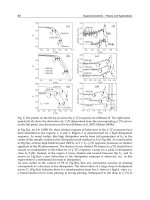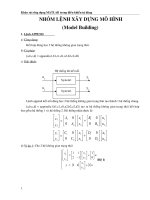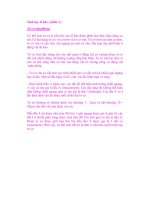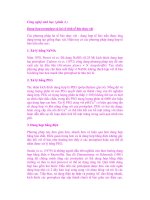Theory Power Electronics phần 4 potx
Bạn đang xem bản rút gọn của tài liệu. Xem và tải ngay bản đầy đủ của tài liệu tại đây (759.99 KB, 13 trang )
© 2000 by CRC Press LLC
(also called clamped-mode or PWM operation) method. Figure 30.37 illustrates the clamped-mode
fixed-frequency operation of the SPRC. The load power control is achieved by changing the phase-shift
angle f between the gating signals to vary the pulsewidth of v
AB
.
4.Design example. Design a 500-W output SPRC (half-bridge version) with secondary-side resonance
(operation in lagging PF mode and variable-frequency control) with the following specifications:
Minimum input supply voltage = 2E
min
= 230 V
Load voltage, V
o
= 48 V
Switching frequency, f
s
= 100 kHz
Maximum load current = 10.42 A
As explained in item 2, C
s
/C
t
= 1 is chosen. Using the constraints (1) minimum kVA rating of tank circuit
per kW output power, (2) minimum inverter output peak current, and (3) enough turn-off time for the
switches, it can be shown that [Bhat, 1991] Q
s
= 4 and y
s
= 1.1 satisfy the design constraints. From
Fig. 30.36, M = 0.8 p.u.
Average load voltage referred to the primary side of the HF transformer = 0.8 ן 115 V = 92 V.
Therefore, the transformer turns ratio required Ӎ1.84.
The values of L
s
and C
s
can be obtained by solving
Solving the above equations gives L
s
= 109 mH and C
s
= 0.0281 mF. Leakage inductance (L
p
+ L¢
s
) of the
HF transformer can be used as part of L
s
. Typical value for a 100-kHz practical transformer (using Tokin
FIGURE 30.36The converter gain M (p.u.) (normalized output voltage) versus normalized switching frequency y
s
of SPRC
operating above resonance for C
s
/C
t
= 1.
¢
=
æ
è
ç
ö
ø
÷
=WRn
V
P
L
o
o
2
2
156.
L
C
LC
f
y
s
s
r
ss
s
s
æ
è
ç
ö
ø
÷
=´ = =
12
12
4156
1
2
/
/
.
()
W and wp
© 2000 by CRC Press LLC
Mn-Zn 2500B2 Ferrite, E-I type core) for this application is about 5 mH. Therefore, the external resonant
inductance required is L = 104 mH.
Since C
s
/C
t
= 1 is chosen, C
t
= 0.0281 mF. The actual value of C
t
used on the secondary side of the
HF transformer = (1.84)
2
ן 0.0281 = 0.09514 mF. The resonating capacitors must be HF type (e.g.,
polypropylene) and must be capable of withstanding the voltage and current ratings obtained above
(enough safety margin must be provided).
Using Eqs. (30.9) and (30.11) to (30.13):
Peak current through switches = 7.6 A
Peak voltage across C
s
, V
csp
= 430 V
Peak voltage (on secondary side) across C¢
t
, V
ctp
= 76 V
Peak current through capacitor C¢
t
(on secondary side), I
ctp
= 4.54 A
FIGURE 30.37 (a) Basic circuit diagram of series-parallel resonant converter suitable for fixed-frequency operation with
PWM (clamped-mode) control. (b) Waveforms to illustrate the operation of fixed-frequency PWM series-parallel resonant
converter working with a pulsewidth d.
© 2000 by CRC Press LLC
A simple control circuit can be built using PWM IC SG3525 and TSC429 MOSFET driver ICs.
With the development of digital ICs operating on low-voltage (of the order of 3 V) supplies, use of
MOSFETs as synchronous rectifiers with very low voltage drop (~0.2 V) has become essential [Motorola,
1989] to increase the efficiency of the power supply.
AC Power Supplies
Some applications of ac power supplies are ac motor drives,
uninterruptible power supply (UPS) used as a standby ac source
for critical loads (e.g., in hospitals, computers), and dc source-
to-utility interface (either to meet peak power demands or to
augment energy by connecting unconventional energy sources
like photovoltaic arrays to the utility line). In ac induction motor
drives, the ac power main is rectified and filtered to obtain a
smooth dc source, and then an inverter (single-phase version is
shown in Fig. 30.38) is used to obtain a variable-frequency, vari-
able-voltage ac source. The sinusoidal pulsewidth modulation
technique described in Section 30.2 can be used to obtain a sinu-
soidal output voltage. Some other methods used to get sinusoidal
voltage output are [Rashid, 1988] a number of phase-shifted
inverter outputs summed in an output transformer to get a
stepped waveform that approximates a sine wave and the use of
a bang-bang controller in Fig. 30.38. All these methods use line-
frequency (60 Hz) transformers for voltage translation and iso-
lation purposes. To reduce the size, weight, and cost of such
systems, one can use dc-to-dc converters (discussed earlier) as an intermediate stage. Figure 30.39 shows such
a system in block schematic form. One can use an HF inverter circuit (discussed earlier) followed by a cycloconverter
stage. The major problem with these schemes is the reduction in efficiency due to the extra power stage. Figure
30.40 shows a typical UPS scheme. The battery shown has to be charged by a separate rectifier circuit.
AC-to-ac conversion can also be achieved using cycloconverters [e.g., Rashid, 1988].
Special Power Supplies
Using the inverters and cycloconverters, it is possible to realize bidirectional ac and dc power supplies. In these
power supplies [Rashid, 1988], power can flow in both directions, i.e., from input to output or from output
to input. It is also possible to control the ac-to-dc converters to obtain sinusoidal line current with unity PF
and low harmonic distortion at the ac source.
FIGURE 30.38An inverter circuit to obtain variable-voltage, variable-frequency ac source. Using sinusoidal pulsewidth
modulation control scheme, sine-wave ac output voltage can be obtained.
FIGURE 30.39AC power supplies using HF
switching (PWM or resonant) dc-to-dc converter
as an input stage. HF transformer isolated dc-to-
dc converters can be used to reduce the size and
weight of the power supply. Sinusoidal voltage
output can be obtained using the modulation in
the output inverter stage or in the dc-to-dc con-
verter.
© 2000 by CRC Press LLC
Defining Terms
Converter: A circuit that performs one of the following power conversions — ac to dc, dc to dc, dc to ac, or
ac to ac.
Cycloconverter: A power electronic circuit that converts ac input to ac output (generally) of lower frequency
than the input source without using any intermediate dc state.
Inverter: A power electronic circuit that converts dc input to ac output.
Isolated: A power electronic circuit that has ohmic isolation between the input source and the load circuit.
Pulsewidth-modulated (PWM) converters: A power electronic converter that employs square-wave switching
waveforms with variation of pulsewidth for controlling the load voltage.
Regulated output: Output load voltage is kept at the required value for changes in either the load or the
input supply voltage.
Resonant converters: A power electronic converter that employs “LC resonant circuits” to obtain sinusoidal
switching waveforms.
Uninterruptible power supply (UPS): A stand-by dc-to-ac inverter used mostly to provide an emergency
power to loads at mains frequency (50/60 Hz) in the event of a mains failure.
References
A.K.S. Bhat, “A unified approach for the steady-state analysis of resonant converters,” IEEE Trans. Industrial
Electronics, vol. 38, no. 4, pp. 251–259, Aug. 1991.
A.K.S. Bhat, “Fixed frequency PWM series-parallel resonant converter,” IEEE Trans. Industry Applications, vol.
28, no. 5, pp. 1002–1009, 1992.
E.R. Hnatek, Design of Solid-State Power Supplies, 2nd ed., New York: Van Nostrand Reinhold, 1981.
K.H. Liu and F.C. Lee, “Zero-Voltage Switching Technique In DC/DC Converters,” IEEE Power Electronics
Specialists Conference Record, 1986, pp. 58–70.
K.H. Liu, R. Oruganti, and F.C. Lee, “Resonant Switches—Topologies and Characteristics,” IEEE Power Elec-
tronics Specialists Conference Record, 1985, pp. 106–116.
Motorola, Linear/Switchmode Voltage Regulator Handbook, 1989.
Philips Semiconductors, Power Semiconductor Applications, 1991.
M.H. Rashid, Power Electronics: Circuits, Devices, and Applications, Englewood Cliffs, N.J.: Prentice-Hall, 1988.
R. Severns and G. Bloom, Modern Switching DC-to-DC Converters, New York: Van Nostrand Reinhold, 1988.
R.L. Steigerwald, “A comparison of half-bridge resonant converter topologies,” IEEE Trans. Power Electron., vol.
PE-3, no. 2, pp. 174–182, April 1988.
K.K. Sum, Recent Developments in Resonant Power Conversion, Calif.: Intertech Communications, 1988.
Unitrode Switching Regulated Power Supply Design Seminar Manual, Lexington, Mass.: Unitrode Corporation, 1984.
FIGURE 30.40 A typical arrangement of UPS system. The load gets power through the static switch when the ac main
supply is present. The inverter supplies power when the main supply fails.
© 2000 by CRC Press LLC
Further Information
The following monthly magazines and conference records publish papers on the analysis, design, and experi-
mental aspects of power supply configurations and their applications:
IEEE Transactions on Power Electronics, IEEE Transactions on Industrial Electronics, IEEE Transactions on Industry
Applications, and IEEE Transactions on Aerospace and Electronic Systems.
IEEE Power Electronics Specialists Conference Records, IEEE Applied Power Electronics Conference Records, IEEE
Industry Applications Conference Records, and IEEE International Telecommunications Energy Conference
Records.
30.4 Converter Control of Machines
Bimal K. Bose
Converter-controlled electrical machine drives are very important in modern industrial applications. Some
examples in the high-power range are metal rolling mills, cement mills, and gas line compressors. In the
medium-power range are textile mills, paper mills, and subway car propulsion. Machine tools and computer
peripherals are examples of converter-controlled electrical machine drive applications in the low-power range.
The converter normally provides a variable-voltage dc power source for a dc motor drive and a variable-
frequency, variable-voltage ac power source for an ac motor drive. The drive system efficiency is high because
the converter operates in switching mode using power semiconductor devices. The primary control variable of
the machine may be torque, speed, or position, or the converter can operate as a solid-state starter of the
machine. The recent evolution of high-frequency power semiconductor devices and high-density and econom-
ical microelectronic chips, coupled with converter and control technology developments, is providing a tre-
mendous boost in the applications of drives.
Converter Control of DC Machines
The speed of a dc motor can be controlled by controlling the dc voltage across its armature terminals. A phase-
controlled thyristor converter can provide this dc voltage source. For a low-power drive, a single-phase bridge
converter can be used, whereas for a high-power drive, a three-phase bridge circuit is preferred. The machine
can be a permanent magnet or wound field type. The wound field type permits variation and reversal of field
and is normally preferred in large power machines.
Phase-Controlled Converter DC Drive
Figure 30.41 shows a dc drive using a three-phase thyristor bridge converter. The converter rectifies line ac
voltage to variable dc output voltage by controlling the firing angle of the thyristors. With rated field excitation,
as the armature voltage is increased, the machine will develop speed in the forward direction until the rated,
or base, speed is developed at full voltage when the firing angle is zero. The motor speed can be increased
further by weakening the field excitation. Below the base speed, the machine is said to operate in constant
FIGURE 30.41Three-phase thyristor bridge converter control of a dc machine.
© 2000 by CRC Press LLC
torque region, whereas the field weakening mode is defined as the constant power region. At any operating
speed, the field can be reversed and the converter firing angle can be controlled beyond 90 degrees for
regenerative braking mode operation of the drive. In this mode, the motor acts as a generator (with negative
induced voltage) and the converter acts as an inverter so that the mechanical energy stored in the inertia is
converted to electrical energy and pumped back to the source. Such two-quadrant operation gives improved
efficiency if the drive accelerates and decelerates frequently. The speed of the machine can be controlled with
precision by a feedback loop where the command speed is compared with the machine speed measured by a
tachometer. The speed loop error generally generates the armature current command through a compensator.
The current is then feedback controlled with the firing angle control in the inner loop. Since torque is
proportional to armature current (with fixed field), a current loop provides direct torque control, and the drive
can accelerate or decelerate with the rated torque. A second bridge converter can be connected in antiparallel
so that the dual converter can control the machine speed in all the four quadrants (motoring and regeneration
in forward and reverse speeds).
Pulsewidth Modulation Converter DC Machine Drive
Four-quadrant speed control of a dc drive is also possible using an H-bridge pulsewidth modulation (PWM)
converter as shown in Fig. 30.42. Such drives (using a permanent magnet dc motor) are popular in low-power
applications, such as robotic and instrumentation drives. The dc source can be a battery or may be obtained
from ac supply through a diode rectifier and filter. With PWM operation, the drive response is very fast and
the armature current ripple is small, giving less harmonic heating and torque pulsation. Four-quadrant oper-
ation can be summarized as follows:
Quadrant 1: Forward motoring (buck or step-down converter mode)
Q
1
—on
Q
3
, Q
4
—off
Q
2
—chopping
Current freewheeling through D
3
and Q
1
Quadrant 2: Forward regeneration (boost or step-up converter mode)
Q
1
, Q
2
, Q
3
—off
Q
4
—chopping
Current freewheeling through D
1
and D
2
Quadrant 3: Reverse motoring (buck converter mode)
Q
3
—on
Q
1
, Q
2
—off
Q
4
—chopping
Current freewheeling through D
1
and Q
3
Quadrant 4: Reverse regeneration (boost converter mode)
Q
1
, Q
3
, Q
4
—off
Q
2
—chopping
Current freewheeling through D
3
and D
4
FIGURE 30.42Four-quadrant dc motor drive using an H-bridge converter.
© 2000 by CRC Press LLC
Often a drive may need only a one- or two-quadrant mode of operation. In such a case, the converter topology
can be simple. For example, in one-quadrant drive, only Q
2
chopping and D
3
freewheeling devices are required,
and the terminal A is connected to the supply positive. Similarly, a two-quadrant drive will need only one leg
of the bridge, where the upper device can be controlled for motoring mode and the lower device can be
controlled for regeneration mode.
Converter Control of AC Machines
Although application of dc drives is quite common, disadvantages are that the machines are bulky and expensive,
and the commutators and brushes require frequent maintenance. In fact, commutator sparking prevents
machine application in an unclean environment, at high speed, and at high elevation. AC machines, particularly
the cage-type induction motor, are favorable when compared with all the features of dc machines. Although
converter system, control, and signal processing of ac drives is definitely complex, the evolution of ac drive
technology in the past two decades has permitted more economical and higher performance ac drives. Conse-
quently, ac drives are finding expanding applications, pushing dc drives towards obsolescence.
Voltage-Fed Inverter Induction Motor Drive
A simple and popular converter system for speed control of an induction motor is shown in Fig. 30.43. The
front-end diode rectifier converts 60 Hz ac to dc, which is then filtered to remove the ripple. The dc voltage is
then converted to variable-frequency, variable-voltage output for the machine through a PWM bridge inverter.
Among a number of PWM techniques, the sinusoidal PWM is common, and it is illustrated in Fig. 30.44 for
one phase only. The stator sinusoidal reference phase voltage signal is compared with a high-frequency carrier
wave, and the comparator logic output controls switching of the upper and lower transistors in a phase leg.
The phase voltage wave shown refers to the fictitious center tap of the filter capacitor. With the PWM technique,
the fundamental voltage and frequency can be easily varied. The stator voltage wave contains high-frequency
ripple, which is easily filtered by the machine leakage inductance. The voltage-to-frequency ratio is kept constant
to provide constant airgap flux in the machine. The machine voltage-frequency relation, and the corresponding
torque, stator current, and slip, are shown in Fig. 30.45. Up to the base or rated frequency w
b
, the machine can
develop constant torque. Then, the field flux weakens as the frequency is increased at constant voltage. The
speed of the machine can be controlled in a simple open-loop manner by controlling the frequency and
maintaining the proportionality between the voltage and frequency. During acceleration, machine-developed
torque should be limited so that the inverter current rating is not exceeded. By controlling the frequency, the
operation can be extended in the field weakening region. If the supply frequency is controlled to be lower than
the machine speed (equivalent frequency), the motor will act as a generator and the inverter will act as a rectifier,
and energy from the motor will be pumped back to the dc link. The dynamic brake shown is nothing but a
buck converter with resistive load that dissipates excess power to maintain the dc bus voltage constant. When
FIGURE 30.43Diode rectifier PWM inverter control of an induction motor.
© 2000 by CRC Press LLC
the motor speed is reduced to zero, the phase sequence of the inverter can be reversed for speed reversal.
Therefore, the machine speed can be easily controlled in all four quadrants.
Current-Fed Inverter Induction Motor Drive
The speed of a machine can be controlled by a current-fed inverter as shown in Fig. 30.46. The front-end
thyristor rectifier generates a variable dc current source in the dc link inductor. The dc current is then converted
to six-step machine current wave through the inverter. The basic mode of operation of the inverter is the same
as that of the rectifier, except that it is force-commutated, that is, the capacitors and series diodes help
commutation of the thyristors. One advantage of the drive is that regenerative braking is easy because the
FIGURE 30.44Sinusoidal pulse width modulation principle.
FIGURE 30.45Voltage-frequency relation of an induction motor.
© 2000 by CRC Press LLC
rectifier and inverter can reverse their operation modes. Six-step machine current, however, causes large
harmonic heating and torque pulsation, which may be quite harmful at low-speed operation. Another disad-
vantage is that the converter system cannot be controlled in open loop like a voltage-fed inverter.
Current-Fed PWM Inverter Induction Motor Drive
The force-commutated thyristor inverter in Fig. 30.46 can be replaced by a self-commutating gate turn-off
(GTO) thyristor PWM inverter as shown in Fig. 30.47. The output capacitor bank shown has two functions:
(1) it permits PWM switching of the GTO by diverting the load inductive current, and (2) it acts as a low-pass
filter causing sinusoidal machine current. The second function improves machine efficiency and attenuates the
irritating magnetic noise. Note that the fundamental machine current is controlled by the front-end rectifier,
and the fixed PWM pattern is for controlling the harmonics only. The GTO is to be the reverse-blocking type.
Such drives are popular in the multimegawatt power range. For lower power, an insulated gate bipolar
transistor (IGBT) or transistor can be used with a series diode.
FIGURE 30.46Force-commutated current-fed inverter control of an induction motor.
FIGURE 30.47PWM current-fed inverter control of an induction motor.
© 2000 by CRC Press LLC
Cycloconverter Induction Motor Drive
A phase-controlled cycloconverter can be used for speed control of an ac machine (induction or synchronous
type). Figure 30.48 shows a drive using a three-pulse half-wave or 18-thyristor cycloconverter. Each output
phase group consists of positive and negative converter components which permit bidirectional current flow.
The firing angle of each converter is sinusoidally modulated to generate the variable-frequency, variable-voltage
output required for ac machine drive. Speed reversal and regenerative mode operation are easy. The cyclocon-
verter can be operated in blocking or circulating current mode. In blocking mode, the positive or negative
converter is enabled, depending on the polarity of the load current. In circulating current mode, the converter
components are always enabled to permit circulating current through them. The circulating current reactor
between the positive and negative converter prevents short circuits due to ripple voltage. The circulating current
mode gives simple control and a higher range of output frequency with lower harmonic distortion.
Slip Power Recovery Drive of Induction Motor
In a cage-type induction motor, the rotor current at slip frequency reacting with the airgap flux develops the
torque. The corresponding slip power is dissipated in the rotor resistance. In a wound rotor induction motor,
the slip power can be controlled to control the torque and speed of a machine. Figure 30.49 shows a popular
slip power-controlled drive, known as a static Kramer drive. The slip power is rectified to dc with a diode
rectifier and is then pumped back to an ac line through a thyristor phase-controlled inverter. The method
permits speed control in the subsynchronous speed range. It can be shown that the developed machine torque
is proportional to the dc link current I
d
and the voltage V
d
varies directly with speed deviation from the
synchronous speed. The current I
d
is controlled by the firing angle of the inverter. Since V
d
and V
I
voltages
balance at steady state, at synchronous speed the voltage V
d
is zero and the firing angle is 90 degrees. The firing
angle increases as the speed falls, and at 50% synchronous speed the firing angle is near 180 degrees. This is
practically the lowest speed in static Kramer drive. The transformer steps down the inverter input voltage to
get a 180-degree firing angle at lowest speed. The advantage of this drive is that the converter rating is low
compared with the machine rating. Disadvantages are that the line power factor is low and the machine is
expensive. For limited speed range applications, this drive has been popular.
Wound Field Synchronous Motor Drive
The speed of a wound field synchronous machine can be controlled by a current-fed converter scheme as shown
in Fig. 30.46, except that the forced-commutation elements can be removed. The machine is operated at leading
power factor by overexcitation so that the inverter can be load commutated. Because of the simplicity of
converter topology and control, such a drive is popular in the multimegawatt range.
FIGURE 30.48Cycloconverter control of an induction motor.
© 2000 by CRC Press LLC
Permanent Magnet Synchronous Motor Drive
Permanent magnet (PM) machine drives are quite popular in the low-power range. A PM machine can have
sinusoidal or concentrated winding, giving the corresponding sinusoidal or trapezoidal induced stator voltage
wave. Figure 30.50 shows the speed control system using a trapezoidal machine, and Fig. 30.51 explains the
wave forms. The power MOSFET inverter supplies variable-frequency, variable-magnitude six-step current
wave to the stator. The inverter is self-controlled, that is, the firing pulses are generated by the machine position
sensor through a decoder. It can be shown that such a drive has the features of dc drive and is normally defined
as brushless dc drive. The speed control loop generates the dc current command, which is then controlled by
the hysteresis-band method to construct the six-step phase current waves in correct phase relation with the
induced voltage waves as shown in Fig. 30.51. The drive can easily operate in four-quadrant mode.
Defining Terms
Dynamic brake: The braking operation of a machine by extracting electrical energy and then dissipating it
in a resistor.
Forced-commutation: Switching off a power semiconductor device by external circuit transient.
Four-quadrant:A drive that can operate as a motor as well as a generator in both directions.
Hysteresis-band:A method of controlling current where the instantaneous current can vary within a band.
Insulated gate bipolar transistor (IGBT): A device that combines the features of a power transistor and
MOSFET.
Regenerative braking:The braking operation of a machine by converting its mechanical energy into electrical
form and then pumping it back to the source.
Self-commutation:Switching off a power semiconductor device by its gate or base drive.
Two-quadrant:A drive that can operate as a motor as well as a generator in one direction.
Related Topics
66.1 Generators•66.2 Motors
FIGURE 30.49Slip power recovery control of a wound rotor induction motor.
© 2000 by CRC Press LLC
FIGURE 30.50 Permanent magnet synchronous motor control with PWM inverter.
FIGURE 30.51 Phase voltage and current waves in brushless dc drive.
© 2000 by CRC Press LLC
References
B.K. Bose, Power Electronics and AC Drives, Englewood Cliffs, N.J.: Prentice-Hall, 1986.
B.K. Bose, “Adjustable speed AC drives—A technology status review,” Proc. IEEE, vol. 70, pp. 116–135, Feb. 1982.
B.K. Bose, Modern Power Electronics, New York: IEEE Press, 1992.
J.M.D. Murphy and F.G. Turnbull, Power Electronic Control of AC Motors, New York: Pergamon Press, 1988.
P.C. Sen, Thyristor DC Drives, New York: John Wiley, 1981.









